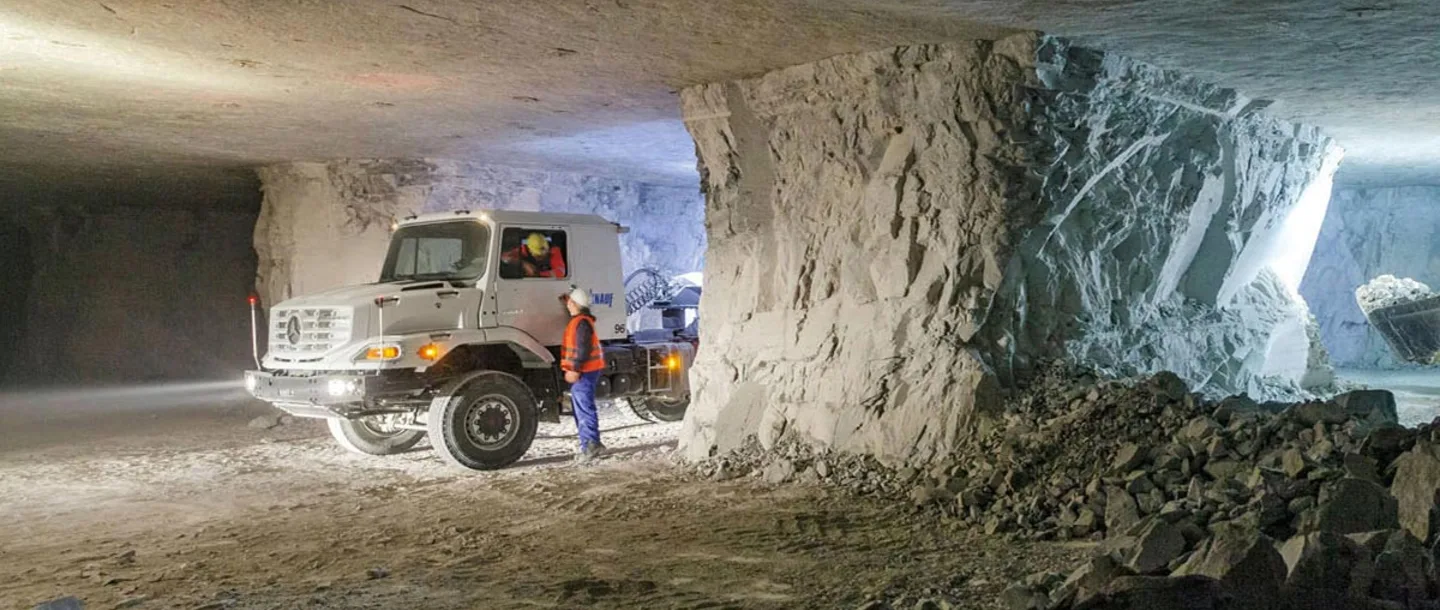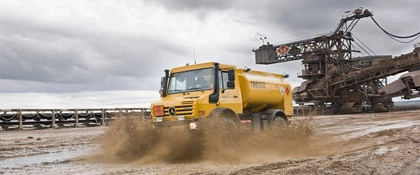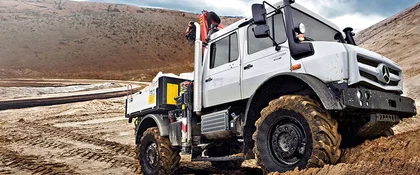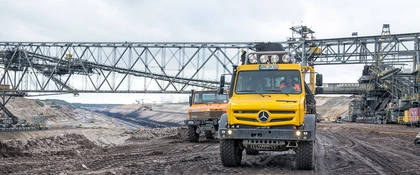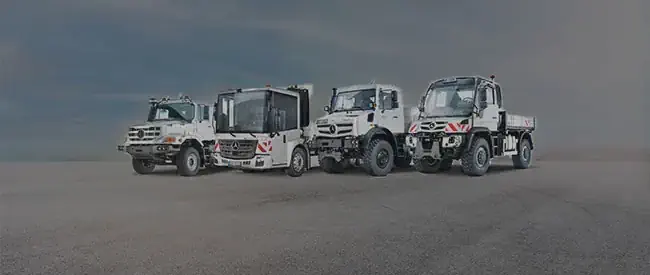The Zetros in the mining industry.
In Hüttenheim in Lower Franconia the company Knauf Gips KG mines for anhydrite. In operation underground, a purpose-configured Zetros shows what it can do.
Above the entrance stands the miners’ motto “Glück auf” (“Best of luck”).
Dust hangs in the air. The illumination of the headlights of the Zetros only extends a few metres into the darkness, then the contours disappear. Every few metres, we see huge, numbered rock columns through our windows to the left and to the right. They bear the mine’s arched roof. Between the stone posts, passages lead into the dark nothingness. The whole mountain is hollowed out, so it’s better not to lose your way down here. “Over time, you learn where you are. But I still haven’t been everywhere yet,” says mining engineer Tobias Beltz. Which is hardly surprising considering the fact that there are more than 160 kilometres of drivable passageways below the ground.
The Hüttenheim mine in Lower Franconia is located about 40 kilometres southeast of Würzburg. It extends over three kilometres in a north-south direction and over two-and-a-half kilometres in an east-west direction. The mine consists of countless passageways, some of them up to 150 metres under the ground that are often without any lighting.
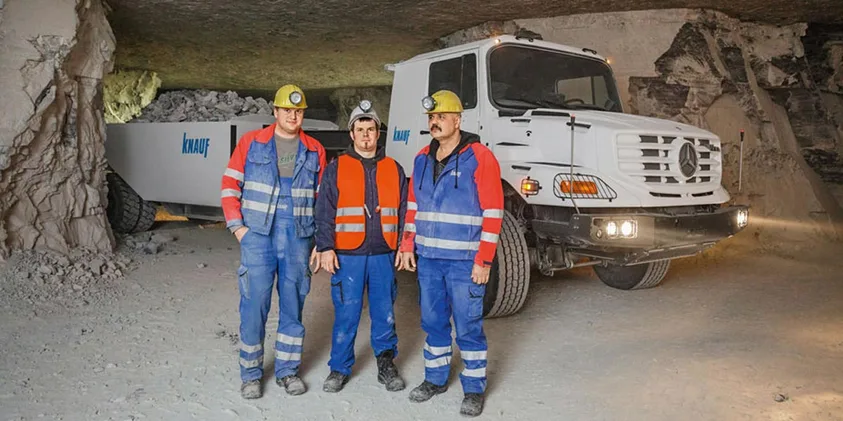
Zetros in action 150 meters under the ground.
The mine is run by the company Knauf Gips, which operates a specially configured Zetros semitrailer tractor unit here that has a particularly low design height. “We were looking for a vehicle which is economical, gives the drivers a comfortable workplace and protects them against dust. At the same time, it needs to be robust and have all-terrain capability, as the route is rocky. Our Zetros must be able to take a lot of punishment,” says master motor mechanic Norbert Feilner, who is responsible for Knauf’s fleet. The Zetros pulls behind it a gooseneck semitrailer, which has a carrying capacity of 23 tonnes and was developed by Knauf itself to enable a better distribution of weight. The speed of the all-wheel-drive vehicle with its automatic transmission has been limited to 30 kilometres per hour. It is fitted with cameras that help the drivers when manoeuvring. “The system has proven itself,” explains Feilner.
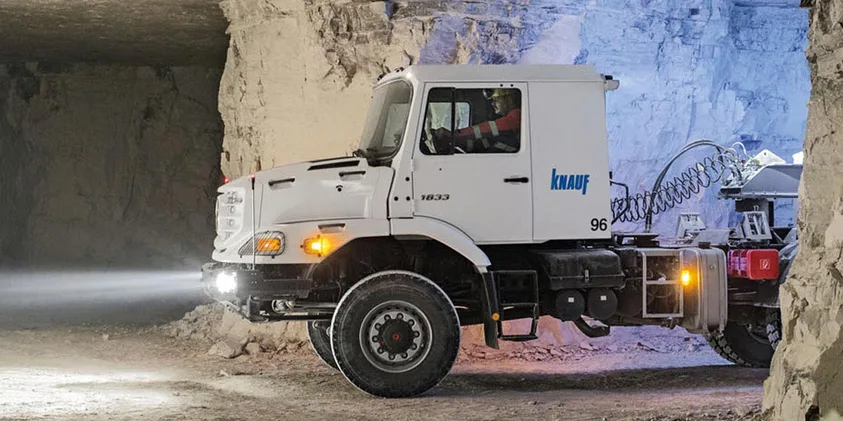
Did you know?
Who is allowed to mine for which natural resources in Germany is laid down in the German Mining Act. In the Act, natural resources are classified as either “bergfrei” or “grundeigen”. The former relates to gas, coal, oil, silver and gold, to which the state has a right of access. The latter refers to natural resources that include sands and gravels, gypsum and also anhydrite, which belong to the respective land owners. Anyone who wants to mine these has to reach agreement with those owners. In the case of Hüttenheim, there were over 200 such owners: the Tannenberg beneath which the drilling and blasting is carried out is a vineyard with lots of small plots of land.
Anhydrite, a dry, gypsum-like sediment mineral, which is deposited after water has evaporated, has been mined in Hüttenheim since 1957. About 220 million years ago, the region of Lower Franconia was located at the edge of a sea. The climate was subtropical. A lagoon extended from the Rhön mountains to the north down to near Schwäbisch Hall in the south. A layer of anhydrite eight metres thick was deposited in the bay.
Mining in Hüttenheim moves along this layer. Access into the Tannenberg mountain is at ground level. Above the entrance stands the miners’ motto “Glück auf” (“Best of luck”). Shortly after entering the mine, an illuminated statue of the Saint Barbara, the patron saint of the miners, stands at a forked junction. Only the lower four metres of the anhydrite layer are mined, as the upper four have been too strongly impurified by clay and limestone to be used.
“Mining is done by drilling and blasting,” explains mining engineer Beltz. The blast holes are cut into the rock at a depth of three metres with the help of a special drilling jumbo. A successful detonation releases about 200 tonnes of anhydrite. For a daily extraction output of just under 1,000 tonnes, five to six blast sites per day are needed, as not every blast is successful.
We’re checking whether we could also operate the Zetros in other mines.
Tobias Beltz, mining engineer, Hüttenheim mine
The detonations are carried out at the end of the late shift at about 9.30 p.m. This is because the explosions can release toxic gases, but these dissipate during the course of the night. The early shift can then begin safely with the removal work. A main ventilation shaft ensures that there is plenty of fresh air. A huge ventilator sucks 2,500 cubic metres of fresh air per minute into the mine and blows out the foul air.
Dust swirls up, filling the mine and impairing visibility. Lumps of anhydrite the size of a football fall out of the wheel loader bucket into the semitrailer of the Zetros. The material feels firm and cool. “This is really hard stuff,” says Beltz. The temperature here under the ground is also cool, at a constant 14 degrees Celsius.
No sooner has the truck been loaded than the Zetros drives off. The underground passageways are at most six metres wide and four metres high. Neon tubes only hang from the roof along the main routes. The destination of the Zetros is the crusher. This plant is between two and three kilometres away, depending on where the anhydrite is loaded. The material is broken down into smaller pieces there, which should not be bigger than 6.5 centimetres. A conveyor belt transports the broken rock directly to the processing plant outside. The anhydrite is ground there and aggregates are added to form screed.
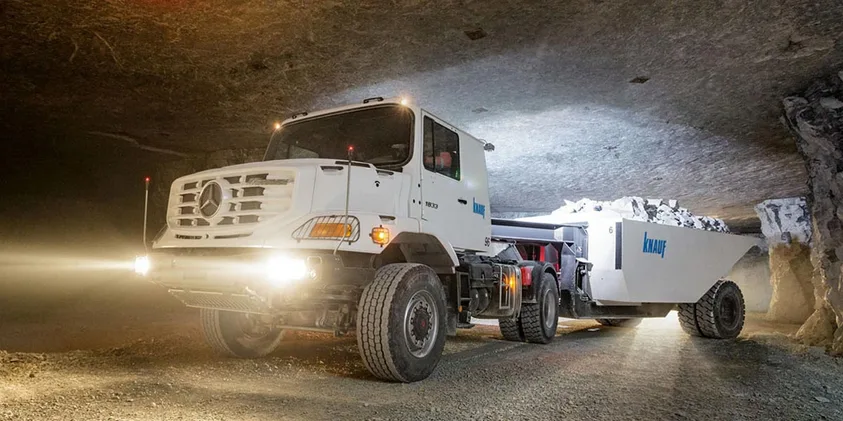
The headlights of the Zetros illuminate Tobias Beltz’s safety vest. The mining engineer wears safety shoes, overalls, and, of course, a helmet with a mining lamp. The roof above him seems to be smooth, firm and stable. But it was formed from sediments. “If there is a fault in the layer, something may fall down,” Beltz says.
The greatest danger for a mine, however, is flooding. The dry anhydrite can absorb water and then turns into gypsum. Its volume increases during this process by up to 30 per cent and it develops explosive forces. The Hüttenheim mine, however, ranks as absolutely dry. It is sealed off by strong layers of clay. Water could only enter it via old ventilation boreholes and shafts.
The Zetros leaves the crushing plant to fetch new material. Its taillights vanish slowly in the darkness. It has been in operation since Christmas. It is quite possible that its use will serve as a model. Knauf Gips operates mines worldwide: “We’re currently checking whether we could also operate the Zetros in other mines,” says Tobias Beltz.
